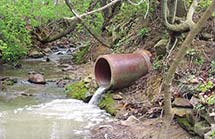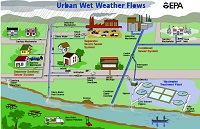On Thursday, I went with one of my heroes from the Lower East Side Ecology Center, Kate Zidar, to look at a “combined sewer overflow” (CSO). Now what I’m about to tell you is gross, so if you have a strong gag reflex…
The CSO that Kate showed me, down on the East River, is one of nearly 700 that occasionally dump raw sewage into New York Harbor and the surrounding waterways. The good news is that there are only 70 such emissions a year, according to Kate. The bad news is that that amounts to 27 billion gallons of untreated wastewater in New York City waterways annually (that’s the gag bit).
What happens is that both the household sewage from our homes and the storm water drainage from the streets and rooftops of the buildings come together in underground drainage pipes that take it all to wastewater treatment plants (click on the above diagram for a larger version). During a hard rain, however, those underground sewage pipes get overwhelmed and, to keep the sewage from backing up into our sinks and toilets, it gets dumped, untreated, through the CSOs into the rivers and waterways.
Want to go swimming?
Not in New York, right? Well, it turns out there are a lot of other places you may not be rushing
to don your bathing suits either. According to the EPA:
 “Combined sewer systems serve roughly 772 communities containing about 40 million people. Most communities with combined sewer systems (and therefore with CSOs) are located in the Northeast and Great Lakes regions, and the Pacific Northwest (see map).”
“Combined sewer systems serve roughly 772 communities containing about 40 million people. Most communities with combined sewer systems (and therefore with CSOs) are located in the Northeast and Great Lakes regions, and the Pacific Northwest (see map).”
And the discharge isn’t just poo. It can contain industrial waste and just about anything people pour down their toilets or into the sewers: car oil, bleach, ammonia, antifreeze, bug repellent, rat poison and every other toxin you can imagine (picture of a CSO in Pennsylvania courtesy of the Larson Design Group).
Here are some other people’s ideas of what we can do to stop the pollution that flows from CSOs (I’m still working up to the sustainable water consumption part of the No Impact project so can’t yet share my own techniques):
- Reduce water use so less wastewater enters the sewer system and it is less likely to overflow.
- Manage storm water so that less of it enters the sewer systems.
- Develop “end of pipe” innovations that prevent the overflows.
- Don’t put anything but water, pee and poo down the drain (recipes for low impact soaps and household cleansers here).
Finally, watch Kate Zidar’s really cool video project (made in partnership with the Center for Urban Pedagogy), The Water Underground, a 25-minute student-led exploration of where water comes from, where it goes and what happens along the way.
